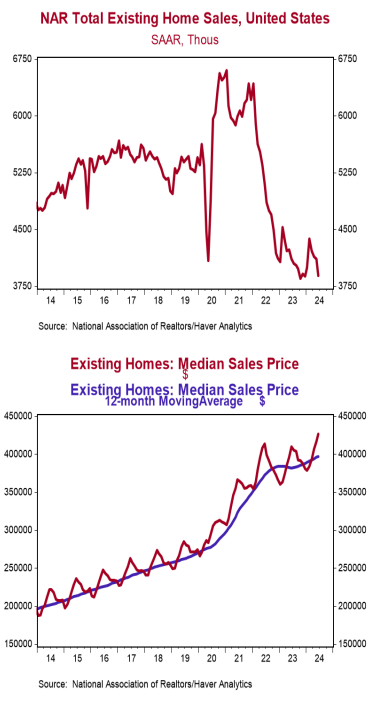- Existing home sales declined 5.4% in June to a 3.890 million annual rate, below the consensus expected 3.980 million. Sales are down 5.4% versus a year ago.
- Sales in June fell in all the major regions. The drop in June was due to both single-family homes and condos/co-ops.
- The median price of an existing home rose to $426,900 in June (not seasonally adjusted) and is up 4.1% versus a year ago.
Implications: The typically strong spring selling season failed to materialize in 2024, with activity falling 5.4% in June, the fourth decline in a row. It looks like the housing market remains stuck in low gear due to affordability. First, sales are still facing headwinds from mortgage rates that remain above 7% and some buyers are likely delaying purchases until after the Fed delivers on widely anticipated rate cuts. Second, home prices are rising again (hitting a new high in June) with the median price of an existing home up 4.1% from a year ago. Assuming a 20% down payment, the rise in mortgage rates since the Federal Reserve began its current tightening cycle in March 2022 amounts to a 45% increase in monthly payments on a new 30-year mortgage for the median existing home. Eventually, the housing market can adapt to these increases but continued volatility in financing costs will cause some indigestion. Notably, sales of homes priced at $1 million and above have risen 3.6% in the past year versus a decline of 5.4% for all existing home sales. This demonstrates that, at least at the higher end of the market, both buyers and sellers are beginning to adjust to the new reality of higher rates. However, outside the most expensive segment many existing homeowners remain reluctant to sell due to a “mortgage lock-in” phenomenon, after buying or refinancing at much lower rates before 2022. This remains a major impediment to activity by limiting future existing sales (and inventories). However, there are signs of progress with inventories rising 23.4% in the past year. That has helped push the months’ supply of homes (how long it would take to sell existing inventory at the current very slow sales pace) up to 4.1 in June, the highest since May of 2020 although still below the benchmark of 5.0 that the National Association of Realtors uses to denote a normal market. A tight inventory of existing homes means that while the pace of sales looks like 2008, we aren’t seeing that translate to a big decline in prices. In other news on the manufacturing sector, the Richmond Fed index, a measure of factory activity in the mid-Atlantic, fell to -17 in July from -10 in June.





